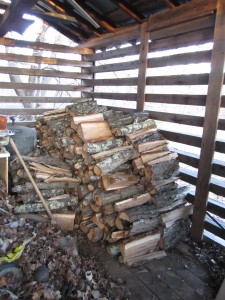In my last post on Winter Homestead Chores I talked about using the shortened days of winter to hibernate, contemplate, and observe nature and your land. For some, especially those of us in colder climes, the best hibernation and contemplation is accomplished while enjoying the warm heat of a wood stove on a cold winter night. But wood stoves, while saving money and energy, require an investment of energy (or money) before they pay toasty dividends.
Basically, you can’t burn without wood. Dry wood. And split wood dries faster, and is easier to carry and load into a hot wood stove.
So today I grabbed my wood splitting tools, and made a nice dent in our stacked pile of chestnut oak rounds. I’ve heard different names for different tools, but today I grabbed a metal splitting maul, or “go-devil,” and a light single-sided ax. Emma’s father made and gave us a wooden maul for splitting wood this Christmas, but I haven’t used it yet. It’s sheer size should help with some of the knottier and hard to split wood we come across, though.
After cleaning out a section of our corn crib turned woodshed, i got into a groove and split about a cord of firewood. One important thing to note when splitting wood is to take some breaks (preferably with sweet potato ginger soup), and to stop when you’re tired. Splitting wood when tired is dangerous and a good way to end up observing the inside of hospital room, or worse.
But if you pay attention to basic safety, splitting wood is a great way to spend a winter afternoon on the homestead. Not only is there a great feeling of accomplishment as each log succumbs, but the addition to the family’s energy independence and reduced fuel costs–as well as the exercise–make wood splitting a great winter homestead chore.
